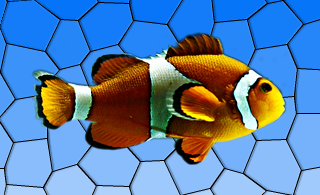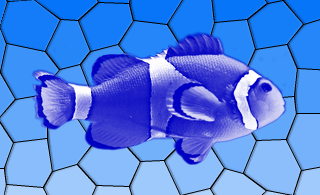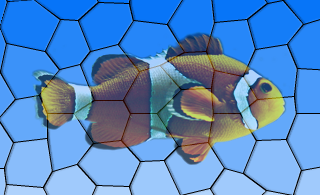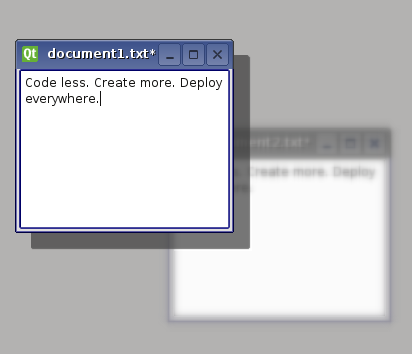QGraphicsEffect¶
The
QGraphicsEffectclass is the base class for all graphics effects. More…

Inherited by: QGraphicsBlurEffect, QGraphicsColorizeEffect, QGraphicsDropShadowEffect, QGraphicsOpacityEffect
New in version 4.6.
Synopsis¶
Functions¶
def
boundingRect()def
drawSource(painter)def
isEnabled()def
sourceBoundingRect([system=Qt.LogicalCoordinates])def
sourceIsPixmap()def
sourcePixmap([system=Qt.LogicalCoordinates[, offset=None[, mode=PadToEffectiveBoundingRect]]])def
updateBoundingRect()
Virtual functions¶
def
boundingRectFor(sourceRect)def
draw(painter)def
sourceChanged(flags)
Slots¶
def
setEnabled(enable)def
update()
Signals¶
def
enabledChanged(enabled)
Detailed Description¶
Effects alter the appearance of elements by hooking into the rendering pipeline and operating between the source (e.g., a
QGraphicsPixmapItem) and the destination device (e.g.,QGraphicsView‘s viewport). Effects can be disabled by callingsetEnabled(false). If effects are disabled, the source is rendered directly.To add a visual effect to a
QGraphicsItem, for example, you can use one of the standard effects, or alternately, create your own effect by creating a subclass ofQGraphicsEffect. The effect can then be installed on the item usingsetGraphicsEffect().Qt provides the following standard effects:
QGraphicsBlurEffect- blurs the item by a given radius
QGraphicsDropShadowEffect- renders a dropshadow behind the item
QGraphicsColorizeEffect- renders the item in shades of any given color
QGraphicsOpacityEffect- renders the item with an opacity






For more information on how to use each effect, refer to the specific effect’s documentation.
To create your own custom effect, create a subclass of
QGraphicsEffect(or any other existing effects) and reimplement the virtual functiondraw(). This function is called whenever the effect needs to redraw. Thedraw()function takes the painter with which to draw as an argument. For more information, refer to the documentation fordraw(). In thedraw()function you can callsourcePixmap()to get a pixmap of the graphics effect source which you can then process.If your effect changes, use
update()to request for a redraw. If your custom effect changes the bounding rectangle of the source, e.g., a radial glow effect may need to apply an extra margin, you can reimplement the virtualboundingRectFor()function, and callupdateBoundingRect()to notify the framework whenever this rectangle changes. The virtualsourceChanged()function is called to notify the effects that the source has changed in some way - e.g., if the source is aQGraphicsRectItemand its rectangle parameters have changed.See also
- class PySide2.QtWidgets.QGraphicsEffect([parent=None])¶
- param parent:
Constructs a new
QGraphicsEffectinstance having the specifiedparent.
- PySide2.QtWidgets.QGraphicsEffect.ChangeFlag¶
This enum describes what has changed in QGraphicsEffectSource.
Constant
Description
QGraphicsEffect.SourceAttached
The effect is installed on a source.
QGraphicsEffect.SourceDetached
The effect is uninstalled on a source.
QGraphicsEffect.SourceBoundingRectChanged
The bounding rect of the source has changed.
QGraphicsEffect.SourceInvalidated
The visual appearance of the source has changed.
- PySide2.QtWidgets.QGraphicsEffect.PixmapPadMode¶
This enum describes how the pixmap returned from
sourcePixmapshould be padded.Constant
Description
QGraphicsEffect.NoPad
The pixmap should not receive any additional padding.
QGraphicsEffect.PadToTransparentBorder
The pixmap should be padded to ensure it has a completely transparent border.
QGraphicsEffect.PadToEffectiveBoundingRect
The pixmap should be padded to match the effective bounding rectangle of the effect.
- PySide2.QtWidgets.QGraphicsEffect.boundingRect()¶
- Return type:
Returns the effective bounding rectangle for this effect, i.e., the bounding rectangle of the source in device coordinates, adjusted by any margins applied by the effect itself.
See also
- PySide2.QtWidgets.QGraphicsEffect.boundingRectFor(sourceRect)¶
- Parameters:
sourceRect –
PySide2.QtCore.QRectF- Return type:
Returns the effective bounding rectangle for this effect, given the provided
rectin the device coordinates. When writing you own custom effect, you must callupdateBoundingRect()whenever any parameters are changed that may cause this this function to return a different value.See also
- PySide2.QtWidgets.QGraphicsEffect.draw(painter)¶
- Parameters:
painter –
PySide2.QtGui.QPainter
This pure virtual function draws the effect and is called whenever the source needs to be drawn.
Reimplement this function in a
QGraphicsEffectsubclass to provide the effect’s drawing implementation, usingpainter.For example:
def draw(self, painter): # ... offset = QPoint() if self.sourceIsPixmap(): # No point in drawing in device coordinates (pixmap will be scaled anyways). pixmap = sourcePixmap(Qt.LogicalCoordinates, offset) ... painter.drawPixmap(offset, pixmap) else: # Draw pixmap in device coordinates to avoid pixmap scaling pixmap = sourcePixmap(Qt.DeviceCoordinates, offset) painter.setWorldTransform(QTransform()) # ... painter.drawPixmap(offset, pixmap) # ...
This function should not be called explicitly by the user, since it is meant for reimplementation purposes only.
- PySide2.QtWidgets.QGraphicsEffect.drawSource(painter)¶
- Parameters:
painter –
PySide2.QtGui.QPainter
Draws the source directly using the given
painter.This function should only be called from
draw().For example:
def draw(self, painter): # Fully opaque draw directly without going through a pixmap. if qFuzzyCompare(self.opacity, 1): drawSource(painter) return # ...
See also
- PySide2.QtWidgets.QGraphicsEffect.enabledChanged(enabled)¶
- Parameters:
enabled – bool
- PySide2.QtWidgets.QGraphicsEffect.isEnabled()¶
- Return type:
bool
This property holds whether the effect is enabled or not..
If an effect is disabled, the source will be rendered with as normal, with no interference from the effect. If the effect is enabled, the source will be rendered with the effect applied.
This property is enabled by default.
Using this property, you can disable certain effects on slow platforms, in order to ensure that the user interface is responsive.
- PySide2.QtWidgets.QGraphicsEffect.setEnabled(enable)¶
- Parameters:
enable – bool
This property holds whether the effect is enabled or not..
If an effect is disabled, the source will be rendered with as normal, with no interference from the effect. If the effect is enabled, the source will be rendered with the effect applied.
This property is enabled by default.
Using this property, you can disable certain effects on slow platforms, in order to ensure that the user interface is responsive.
- PySide2.QtWidgets.QGraphicsEffect.sourceBoundingRect([system=Qt.LogicalCoordinates])¶
- Parameters:
system –
CoordinateSystem- Return type:
Returns the bounding rectangle of the source mapped to the given
system.Calling this function with
DeviceCoordinatesoutside ofdraw()will give undefined results, as there is no device context available.See also
- PySide2.QtWidgets.QGraphicsEffect.sourceChanged(flags)¶
- Parameters:
flags –
ChangeFlags
This virtual function is called by
QGraphicsEffectto notify the effect that the source has changed. If the effect applies any cache, then this cache must be purged in order to reflect the new appearance of the source.The
flagsdescribes what has changed.
- PySide2.QtWidgets.QGraphicsEffect.sourceIsPixmap()¶
- Return type:
bool
Returns
trueif the source effectively is a pixmap, e.g., aQGraphicsPixmapItem.This function is useful for optimization purposes. For instance, there’s no point in drawing the source in device coordinates to avoid pixmap scaling if this function returns
true- the source pixmap will be scaled anyways.
- PySide2.QtWidgets.QGraphicsEffect.sourcePixmap([system=Qt.LogicalCoordinates[, offset=None[, mode=PadToEffectiveBoundingRect]]])¶
- Parameters:
system –
CoordinateSystemoffset –
PySide2.QtCore.QPointmode –
PixmapPadMode
- Return type:
Returns a pixmap with the source painted into it.
The
systemspecifies which coordinate system to be used for the source. The optionaloffsetparameter returns the offset where the pixmap should be painted at using the current painter. For control on how the pixmap is padded use themodeparameter.The returned pixmap is clipped to the current painter’s device rectangle when
systemisDeviceCoordinates.Calling this function with
DeviceCoordinatesoutside ofdraw()will give undefined results, as there is no device context available.See also
- PySide2.QtWidgets.QGraphicsEffect.update()¶
Schedules a redraw of the effect. Call this function whenever the effect needs to be redrawn. This function does not trigger a redraw of the source.
See also
- PySide2.QtWidgets.QGraphicsEffect.updateBoundingRect()¶
This function notifies the effect framework when the effect’s bounding rectangle has changed. As a custom effect author, you must call this function whenever you change any parameters that will cause the virtual
boundingRectFor()function to return a different value.This function will call
update()if this is necessary.
© 2022 The Qt Company Ltd. Documentation contributions included herein are the copyrights of their respective owners. The documentation provided herein is licensed under the terms of the GNU Free Documentation License version 1.3 as published by the Free Software Foundation. Qt and respective logos are trademarks of The Qt Company Ltd. in Finland and/or other countries worldwide. All other trademarks are property of their respective owners.
